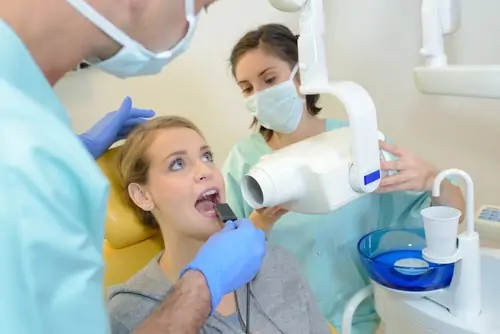
We’re all used to showing our teeth off for photographs. But when it comes to your dentist in Broomfield, we’re more interested in you smiling for a different kind of picture — dental x-rays. Chances are you’ve experienced these diagnostic images at your dental appointments, but what exactly are dental x-rays used for?
There’s not much difference between dental x-rays and ones a physician may take of your leg or arm. X-rays in general use energy to capture images of dense areas inside the body such as bones. Dental x-rays, in particular, are used to show the teeth and bones surrounding the mouth and can help your dentist in Broomfield find problems or potential problems.
Even though all dental x-rays will show your dentist hard areas in your mouth, there are a variety of different types of x-rays that are used to show different things.
Taking a deeper view into the mouth can help your dentist in Broomfield see problematic areas before they even show any outward signs or symptoms. When dental problems are caught early, it makes treatment easier and relieves the patient from experiencing potential pain that probably would have resulted from letting a problem go. Here are a few things your dentist can see with the help of x-rays.
If you’ve ever had a cavity that has progressed into a larger area of decay, you probably noticed some sensitivity or pain in the area. These types of cavities can usually be seen with the naked eye. However, when cavities are still teeny tiny or are wedged in between teeth, they can show no signs and may be missed during a visual exam. This is where x-rays can make a huge difference. X-rays can show these cavities early when treatment is easy.
Infections inside a tooth, also known as an abscess, can be a real pain — literally. So when a patient has a toothache or throbbing tooth pain, their dentist will probably start by taking a few x-rays to get a better idea of what’s going on. X-rays can show deep into the tooth roots and will highlight infections. An abscess may require a root canal, potentially a dental crown, or even an extraction.
Besides teeth, our jawbones are also an important part of our overall oral health. After all, they help hold our teeth in place. But things like age, osteoporosis, gum disease, and prior tooth loss can weaken the bone structure, most of the time without you even knowing it. Dental x-rays can show the progression of bone loss and help your dentist find a solution that’s right for you.
Dental x-rays are a safe way to identify problems lurking below the surface. Depending on your specific needs and health history, your dentist may recommend taking x-rays anywhere from every six months to every three years.
We’re all used to showing our teeth off for photographs. But when it comes to your dentist in Broomfield, we’re more interested in you smiling for a different kind of picture — dental x-rays. Chances are you’ve experienced these diagnostic images at your dental appointments, but what exactly are dental… Read More…